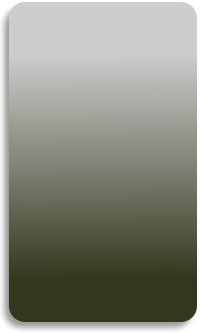


©2015 Deborah Richardson





Privacy Policy
Copyright




Lace Making Equipment
Lace making uses many different tools and equipment. Here is more information on them.
Bobbins
The bobbins used in Bedfordshire and the locality are miniature works of art in their own right -
The shank (main body) of the bobbin was sometimes inscribed with short phrases, names, dates or patterns. These inscriptions could be personal love messages, to commemorate special occasions or just sayings. A few very ornate ivory bobbins have been seen, but these may well have just been for display rather than for use.. Other materials were used, such as glass or silver, but again these may have been ornamental.
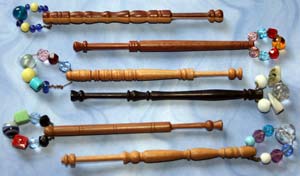
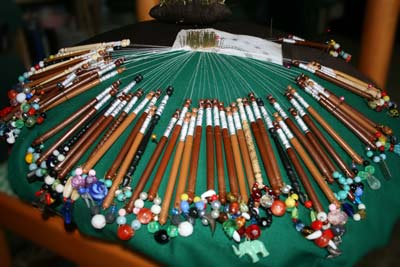

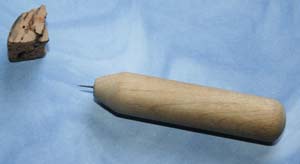
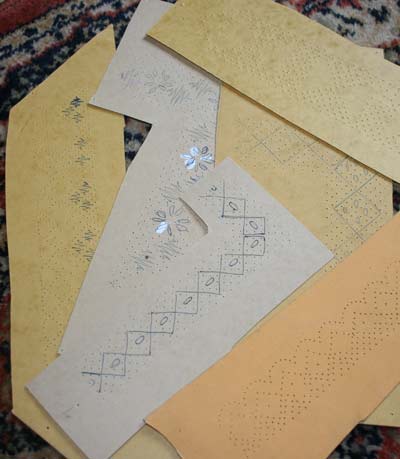
Some turned wooden bobbins with glass bead spangles -
This bookmark is Bedfordshire lace. It took me about 6 hours to make. This is very simple design, featuring plaits or trails between motifs and 'Bedfordshire Buds' -
Lace Pillow ‘in Action’
My first lace making pillow was a simple polystyrene dome, covered in dark brown cotton. There is another piece of cotton fabric pinned over the lower part of the pattern, to stop the threads catching on it.
The design I am working on is using 29 pairs of bobbins. The brown thing at the very back of the pillow is my pincushion.
This is a very simple design, wide pieces of lace could often have hundreds of pairs of bobbins.
The actual process of making the stitches is very easy.. however learning to interpret patterns and following complex ones without getting confused takes many years of practice and study.
Lace Prickings
Here are some old lace prickings.
The lace maker would be lent a master copy of a design, which she would then lay on top of a piece of parchment (nowadays we often use shiny cardboard). She would transfer the design on to the parchment, often using chalk, then would prick all the holds in the design, very carefully, using a 'pricker'. Then she would draw on any lines to show the way it was to be worked.
Many of these prickings are for Torchon laces -
Lace Pricker
Here is a simple pricker for pricking out the patterns. It is just a sharp needle, embedded in a wooden handle.
The thing on the left is a piece of cork that I pop on the end when not in use -
Lace Equipment Video
Here is a Youtube video where I am talking about the equipment used to make Midlands (Bedfordshire & Buckinghamshire) lace.
Lace Making Equipment
The Horse -
Pillow -
Fine brass pins
Bobbins (loads!)
Beads to make Spangles
Prickers to copy patterns
Scissors to cut threads
Pin Cushion
Pins with glass heads
Bobbin Box (or bag)
Patterns for the lace
Bobbin winder
Candles (for light)
Flask -
Irons for crimping
Flour bag to dry hands
Yard-
Lace Beginners Website
A wonderful sire with lots of instructions on how to make lace, ideal for beginners, is Jo Edkins’ Lace Website.
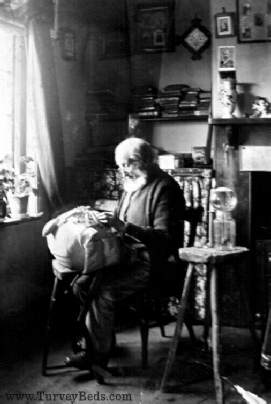
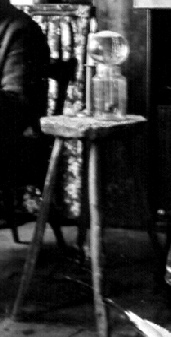
One the left is an old man making lace in a cottage in Olney (just a couple of miles from Turvey). This picture dates from around 1870.
You can click on the picture to enlarge it.
The man is using a round pillow which is balanced on a three legged stool. Hanging at the back of the pillow is his pincushion, and there are is a little fabric double-
The man is working close to the window for light.
When evening comes he will use a “flask”, or focusing lamp which is the glass apparatus you can see on a stool beside him. I have added a close up on the right.
He will light the candle that stands in front of the flask, then place the flask between the candle and his work.
The flask is made of blown glass and filled with water.
This diffuses the light and helps the lacemaker see to work.
There is a lot more about Lighting for the Lacemaker on the LaceNews site.
Brian Lemin has written a fascinating article on how other types of lamps are often called lace maker lamps -
